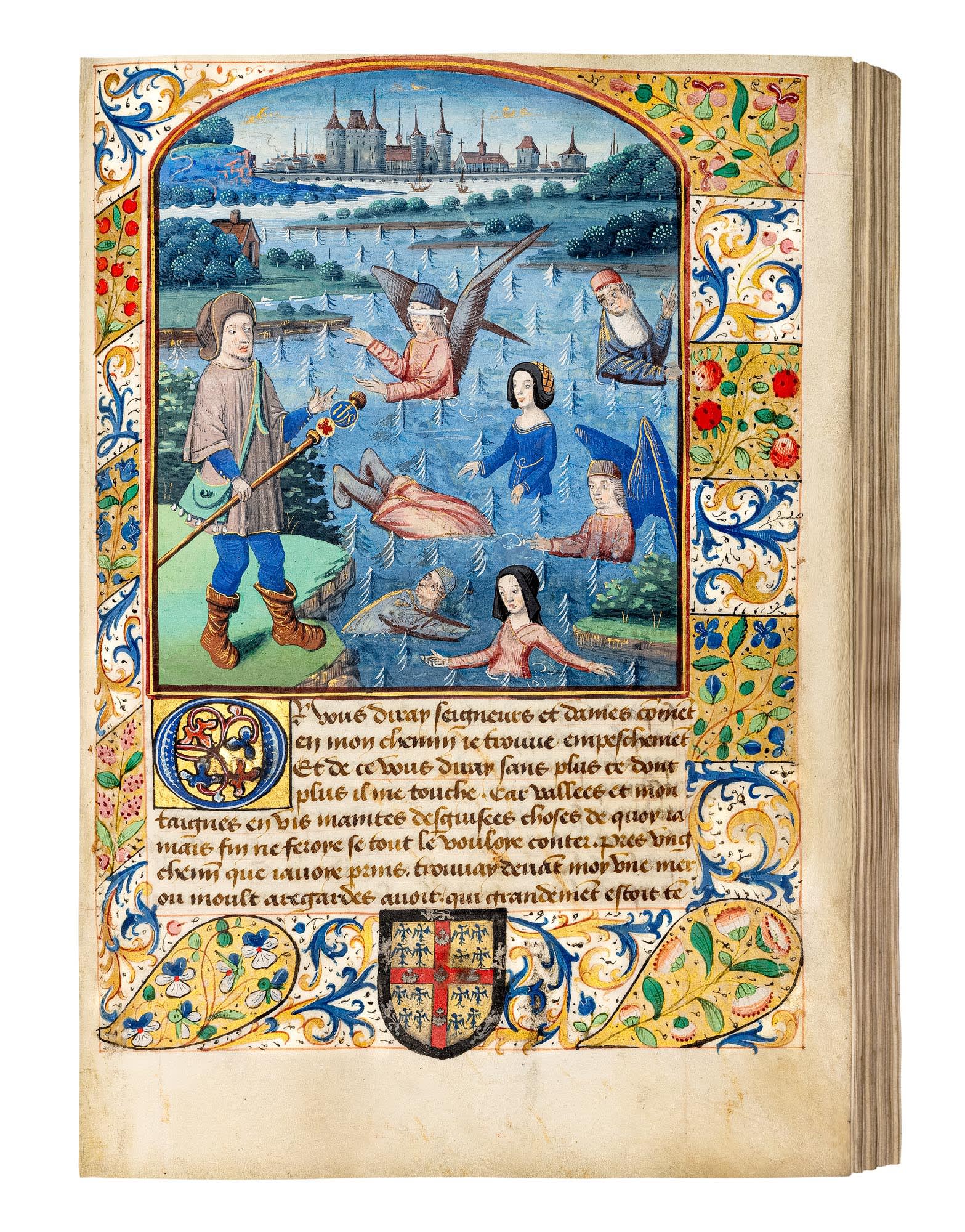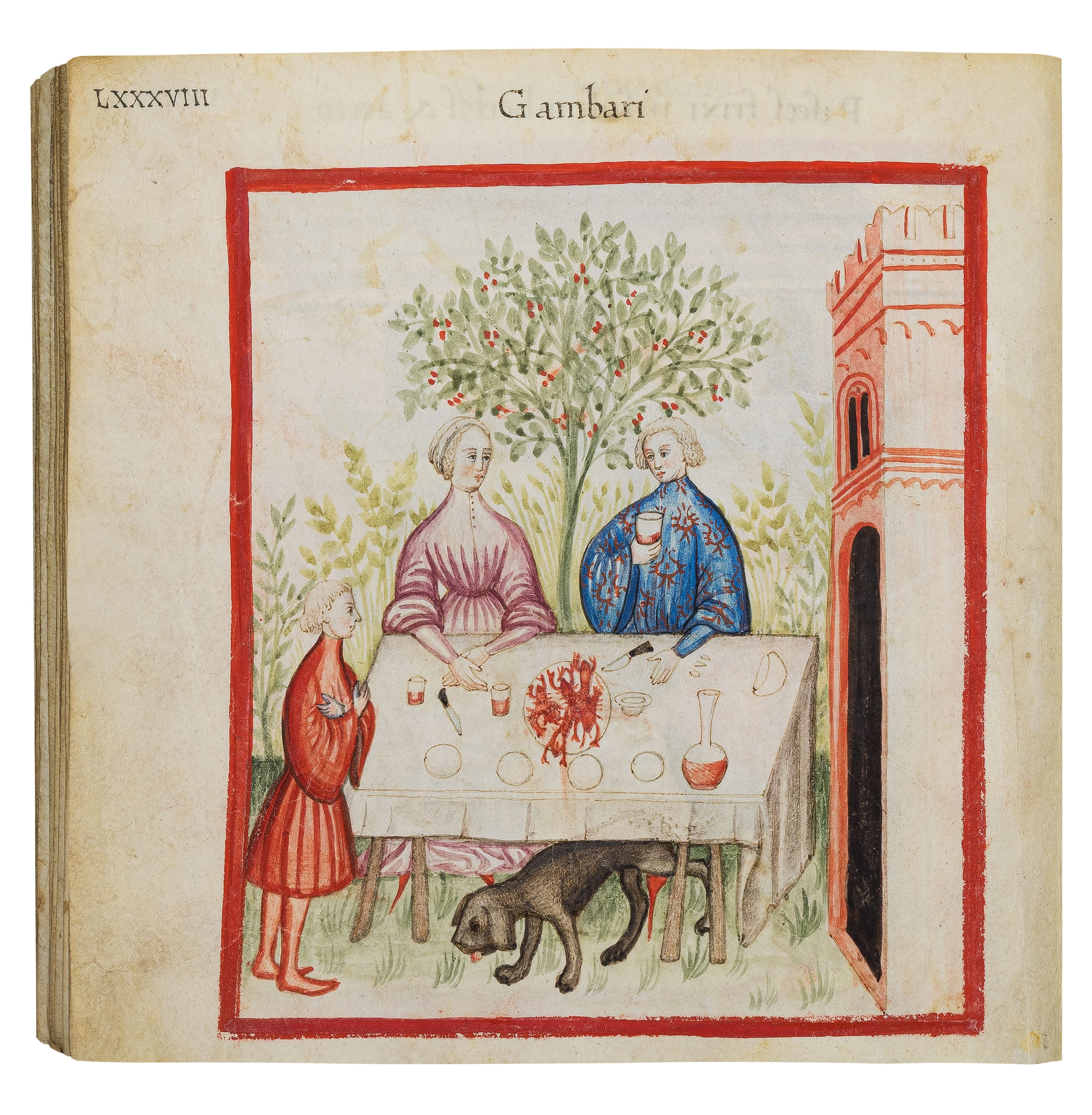

Half-page illumination depicting Guillaume the pilgrim arriving at the Sea of the World fol. 128r. Guillaume de Digulleville, Le Pèlerinage de la vie humaine, in the prose version for Jeanne de Laval, and Le Pèlerinage de l'Âme, in the prose version of Jean Galopes, both texts in French, illuminated manuscript on vellum. Angers and/or Paris c. 1478.
It is a delights to present this beautiful copy of the great literary sensations of the Middle Ages: the prose version of the Pèlerinage de la Vie Humaine and its rare sequel, the Pèlerinage de l’Ame. The two texts only survive together in these specific versions in one other manuscript. In a dream the author, Guillaume de Digulleville, sees the besieged city of Jerusalem and decides to undertake the perilous journey to the city of God himself. Five astonishing half-page illuminations and 91 beautiful miniatures tell the story of his treacherous travels full of temptation and peril to his immortal soul. He encounters grotesque personifications of vices who try and dissuade and hamper his journey. This long-lost manuscript was produced for the wedding of Guyonne de Beauvau and René de Laval in 1478. Ingeniously intertwining religious ideals and entertainment, the text was read by royals and nobles alike.
Read more about the Pèlerinage de la Vie Humaine here.
Magnificent frontispiece depicting the creation of the world in six beautiful illumination froming a striking sequence. fol. 10r. Histoire ancienne jusqu’à César and Faits des Romains, Manuscript in French on vellum, copied by écrivain du roi (royal scribe) Raoulet d’Orléans, illuminated by the Master of the Coronation of Charles VI and a collaborator from his royal atelier. France, Paris, c. 1370-1380.
Our second highlight, is a magnificent chronicle, lavishly decorated with 76 miniatures and two dazzling frontispieces, which was very likely created for King Charles V. The Histoire ancienne jusqu’à César recounts the history of the world from Genesis to the birth of Julius Cesar, while the Faits des Romains, describes decisive battels of Antiquity. The history at hand is densely illuminated with riveting and brutal battle scenes. Despite depicting clashing ancient Roman armies, the figures are rendered in typically medieval dress and armour. The illuminators, the Master of the Coronation of Charles VI and a collaborator, are known to work almost exclusively for the King. Chronicles like this were popular among the highest echelons of society, and often read aloud to royalty and nobles during meals or other quiet moments to edify and entertain them and their courtiers.
Read more about the Histoire Ancienne here.
A couple enjoying some crayfish and redwine while a servant stands by. All the while, a dog is looking for some delicacies which might have made their way to the floor. fol. 44v. The Liechtenstein Tacuinum Sanitatis. Illuminated manuscript in Latin on vellum (illuminated by four distinct artists) Italy, Padua, c. 1450.
Our third highlight, with 130 full-page illuminations, the Liechtenstein Tacuinum Sanitatis is one of the most extensively illuminated medical manuscripts ever produced. It is one of four beautifully decorated copies of this text, although our manuscript is the most elaborate of all surviving exemplars. The Tacuinum Sanitatis offers an all-encompassing guide to well-being, reflected in modern medicine with its holistic understanding of body, mind, and soul. The manuscript consists of 130 fascinating depictions of men and women from different spheres of society, showing them eating and drinking, preparing food, visiting stores, harvesting, talking by the fire, and making music. These glimpses into everyday life are enriched by images of identifiable plants, depictions of the seasons, beloved pets, and animals being led to slaughter. The fascinating images illustrate how to lead a healthy life by regulating eating and drinking, rest and exercise, as well as mental affections. These exceedingly rare insights into everyday life in the 15th century make the Liechtenstein Tacuinum Sanitatis an extraordinary visual witness to this fascinating time and a unique manuscript that is unparalleled on the market.
Read more about the Tacuinum here.




